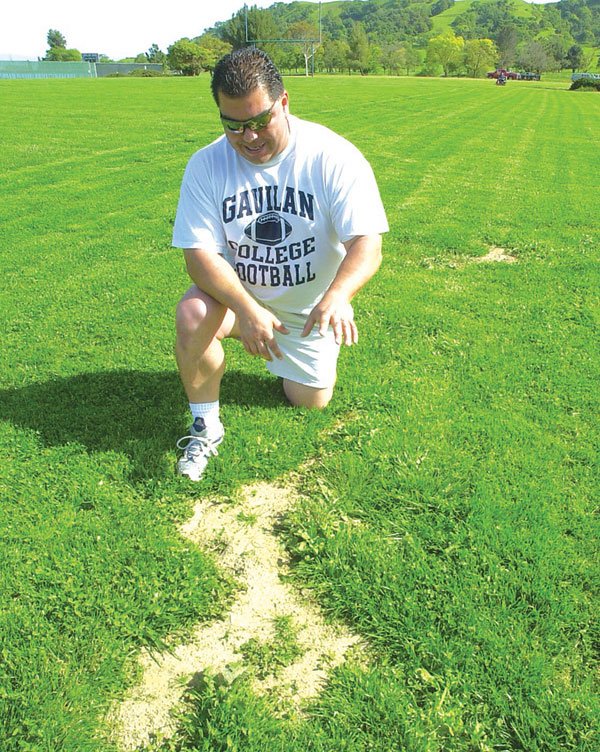Feral pigs wreak havoc each year and can cause thousands of
dollars of damage. They tear up lawns and uproot plants,
frustrating gardeners and home owners.
Feral pigs wreak havoc each year and can cause thousands of dollars of damage. They tear up lawns and uproot plants, frustrating gardeners and home owners.
During the summer months, as the food supply of grass, berries, flowers and nuts disappears, pigs come down from the hills to look for additional sources of nourishment.
They will often tear up yards in the rural parts of Santa Clara and San Benito counties while looking for food, and golf courses are hit especially hard each year. Many golf course managers and home owners have put up hog wire around the premises to try to keep the pigs out.
With the introduction of feral pigs, which are pigs that have escaped captivity, and wild boars, which were brought to North America from Europe and Asia to interbreed with each other there have been changes in the local ecosystem.
Pigs can root up to 15 acres per night and destroy native vegetation in the process, according to a survey by the National Park Service. They often leave the area susceptible to exotic plants that overtake the native plants.
Parks like Pinnacles National Monument have enacted programs to get rid of the non-native pigs, which were first observed in the park in the 1960s. The park has anywhere between 100 pigs in drought years to 900 in wetter years.
The National Park Service is seeking to eliminate 80 to 90 percent of the pig population of the Pinnacles with traps and dog-assisted hunting.
From Pinnacles to Morgan Hill, the pigs are attacking homes and property. John and Millie Knutson, who live on Cienega Road south of Hollister, have seen as many as a dozen or more pigs at once outside their fence they set up around their garden.
And one Morgan Hill couple was charged by a pig while driving to their home east of the city at night. The pig hit them right behind the passenger door, causing $6,000 in damage to their car.
Mike Dunion, who has a home in Carol Estates in Morgan Hill, has had his fair share of pig trouble. He had a quiet year last summer, but in 2003 pigs ripped up his yard like they did in 1998, when there were only five homes in the development.
“They come when they want to come,” Dunion said. “They don’t just roll the grass up, they rip it apart. We’re all watering our lawns during that time of year, so it is like a salad bar. They came four or five nights in a row, and they were so quiet we don’t hear them.”
Dunion said he plans to put up a fence because he can’t afford to keep replacing his lawn each time the pigs get hungry.
Fences can be purchased at any home improvement store, and three-foot fences usually run about $1 to $3 a foot. If you need to keep out deer or other wildlife, you can get a higher fence to serve as a multi-function defense.
And they may be needed come spring. This year’s high crop of acorns may lead to an increase in the pig population in the spring when the litters begin to increase, said Santa Clara County wildlife deputy Henry Coletto. Pigs can have up to 14 piglets twice a year.
“There is a lot of rooting, usually around hills,” Coletto said. “The larger cattle ranges in the Mount Hamilton and Mount Diablo regions lose a lot of their grass lands. They are pretty much confined to hills, but sometimes will come down to golf courses and baseball fields.”
Yet despite their destructive nature, they usually stay away from humans and animals, Coletto said.
“There is always danger with pigs,” Coletto said. “But almost 100 percent of the time it is because they are injured by a hunter or dog. There is never a case when it just attacks someone. Pigs are like any other wild animal. They will run away. But if you lock it up in a garage, it will attack you. More people are attacked by wild deer than pigs. There is usually only a handful of attacks each year in California.”
Pigs can be beneficial as well because they provide aeration for plants and trees and they help spread broad-leaf plants, Coletto said. And some ranchers have earned some extra money by allowing people to hunt on their lands.
But if you want to trap or kill a pig on your property, you need to obtain a permit from the California Department of Fish and Game.
For more information about controlling pigs, go to www.dfg.ca.gov or data2.itc.nps.gov/parks/pinn/ppdocuments/pigFONSI.pdf.













